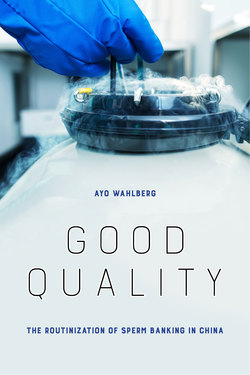Good Quality

Реклама. ООО «ЛитРес», ИНН: 7719571260.
Оглавление
Ayo Wahlberg. Good Quality
Отрывок из книги
Good Quality
THE ROUTINIZATION OF SPERM BANKING IN CHINA
.....
My second overarching objective has been to shift analytical attention away from globalization, exportation, importation, and technology transfer, toward routinization and making when studying reproductive technologies in non-Western parts of the world. Lisa Handwerker (1995), Marcia Inhorn (2003), Aditya Bharadwaj (2003; 2016), Viola Hörbst (2012), and Elizabeth Roberts (2012) have been among the first ethnog-raphers to study the burgeoning use of ARTs outside Europe and America—in China, Egypt, India, Mali, and Ecuador respectively. Com-mon to their studies has been an analytical emphasis on “rapidly globalizing technologies” (Bharadwaj, 2003, p. 1868) through the “wholesale exportation of Western-generated new reproductive technologies into . . . pronatalist developing societies” (Inhorn, 2003, p. 1837). As such, their ethnographies have examined “the importation of Western reproductive technologies” (Handwerker, 2002, p. 310); the “arrival of assisted-reproductive technologies in a developing nation” (Roberts, 2012, p. 39); or the “dissemination of ARTs to Mali” (Hörbst, 2012, p. 194). Although each of these scholars meticulously demonstrates the complex ways in which such a global form as ART becomes recontextualised and reshaped in their specific countries of study, globalization has nevertheless been one of the key ethnographic tropes in studies of reproductive technologies in the so-called Global South. In the case of China (and beyond), I argue that we need to (re-)orient our analyses toward routinization processes, regardless of where sperm banking and insemination treatments were invented.
As will become clear, while global flows and interactions have figured throughout the making of ARTs in China, it would be misleading at best to suggest that they have been imported into, arrived in, or disseminated into the country.11 ARTs are not products; rather, they are assemblages of skills, petri dishes, needles, microscopes, protocols, regulations, patients, donors, clinics, recruitment flyers, advertisements, and more. Hence, accounting for the birth and routinization of ARTs like sperm banking or IVF in China requires a recentering of our analyses. Ethnographic and historical attention is shifted to the ways in which these technologies have followed routes of experimentation, development, and routinization within the nation, in the same way that, for example, Sarah Franklin (1997) and Rayna Rapp (2000) have tracked the routinization of IVF in the United Kingdom or amniocentesis in the United States respectively. It is by focusing on routinization that we can get a sense of how a particular style of sperm banking has emerged in China. As I will show, to the extent that there have been global connections, these have been components rather than drivers of the making of sperm banking in China, just as we know that the development of reproductive technologies in Europe and America have also been facilitated by global connections.
.....